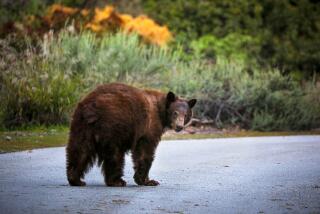THE OUTDOORS : Outdoor Notes / Pete Thomas : Desert Storms Put End to Favorable Outlook for Dove Hunt
Last week’s favorable outlook on the mourning dove hunting season opener Thursday has been downgraded to grim by most Department of Fish and Game personnel, who said the recent thunderstorms in the Southern California deserts will probably mean limited success, if any. Just the same, thousands of hunters are expected to flock to their favorite hunting grounds in hopes that Mother Nature will cooperate long enough for the birds to return to the area, rather than moving south to Mexico.
DFG biologist Andy Pauli, who has been observing bird populations in the Palo Verde Valley from Interstate 10 north, said he expects hunter success there to be about the same as last year, which was poor.
“The weather has been nasty, but there will be some opportunity,” he said. “Last year it was pretty bad and this year could be worse. But we’re still expecting people to be out (hunting).”
Perhaps the area hit hardest by the winds and rain was the Bard-Winterhaven area in the extreme southeast corner of the state, where DFG warden Rusty McBride said conditions “have gone from good to bleak.”
McBride, who last week listed dove populations as 20% larger than 1987’s, said all that has changed.
“We had a major storm move through here Sunday that blew half of Winterhaven away, and with it went the doves,” he said. “Unless we get some birds moving down from up north, it’ll be very bleak (for hunters).”
In the Wister Wildlife area near the Salton Sea and the south Imperial Valley, thunderstorms have been plaguing that area as well, and more bad weather was predicted for the opener.
Two years of drought and a need for irrigation water is resulting in the rapid demise of the East Walker River, one of California’s most popular wild trout fisheries.
According to Phil Pister, a DFG fisheries biologist, the adjacent Bridgeport Reservoir is all but dry, which could spell disaster for the 8-mile stretch of the East Walker River that extends northeast of the Bridgeport Reservoir’s dam.
“The future success of the fishery depends on lots of rainfall, soon,” Pister said. “If we get heavy rainfall, and a good snowpack and run-off this winter, we’ll be back in business.”
Part of the problem, according to Pister, is the Walker Irrigation District, which controls downstream use of water from Bridgeport Reservoir for agricultural use in Nevada.
“The Walker River Irrigation District is taking water out of the reservoir at a rate of 90 cubic feet per second and the flow into the lake is just 25 feet per second,” Pister said.
“We could see significant fish mortality if the stream through the reservoir cuts into the lake bottom (causing siltation).”
A fish rescue operation began Aug. 26, but dead trout could already be seen littering the beaches, according to reports from citizens in the area.
All hope may not be not lost for sport fishing landings that rely on the presence of albacore during the summer months, or for the many fishermen who so far have been unable to get their annual tuna fix. The longfins have made a late showing in the waters off Morro Bay.
The fish were found Saturday aboard the Admiral, a Virg’s Landing sportfisher following up on reports by commercial fishermen off Point Sur. Skipper Sam Kaeli and passengers, after finding nothing in that area, were trolling back to port at about 8 p.m. when they hooked into a school. Seven fish in the 20- to 30-pound class were landed in the dark.
On Monday, five fishermen aboard the Princess found the same school 60 to 68 miles northwest of the Morro Bay coastline, and caught 13 albacore, the largest weighing 32 pounds.
As of 3 p.m. Tuesday, 13 fishermen aboard the Admiral had boated 11 albacore.
According to Virg’s manager Jack Ward, the seas have been smooth, with the water very blue and about 63 1/2 degrees. “Perfect for albacore fishing,” he said.
Hunting license sales in the United States numbered 15,819,366 in 1987, up 46,000 from 1986 and generating more than $345,000,000 in revenue for fish and wildlife services, an all-time record, according to the National Sports Shooting Foundation.
According to the U.S. Fish and Wildlife Service, 29 states posted hunting license gains in 1987. Pennsylvania was nudged from the top hunting state by Texas, which sold 1,190,075 licenses. There were 463,074 license holders in California in 1987.
Fish and Game crews began a scaled-down project to poison brook trout and replace them with Lahontan cutthroat trout in Meiss Meadow lakes and the Upper Truckee River’s headwaters in Northern California.
The project had been cut back after the Tahoe Regional Planning Agency voted against using rotenone or any other poison that could flow into the Tahoe Basin.
The revised project is located entirely within California’s Alpine County, where the TRPA has no jurisdiction even though Meiss Meadow is within Tahoe’s drainage area.
DFG and U.S. Forest Service officials decided to go ahead with the project after consulting with their lawyers, who said dropping the plan entirely might violate the federal Endangered Species Act.
Planting of the endangered Lahontan cutthroat trout is part of a federally required plan to preserve the fish, which used to thrive in the Truckee and Tahoe basins until dams, overfishing and competition from other fish nearly wiped them out.
Biologists say the brook trout must be removed from the project area because cutthroat can’t compete with them. Earlier, crews removed 2,000 brook trout from the waters and transplanted them elsewhere.
More to Read
Sign up for The Wild
We’ll help you find the best places to hike, bike and run, as well as the perfect silent spots for meditation and yoga.
You may occasionally receive promotional content from the Los Angeles Times.






